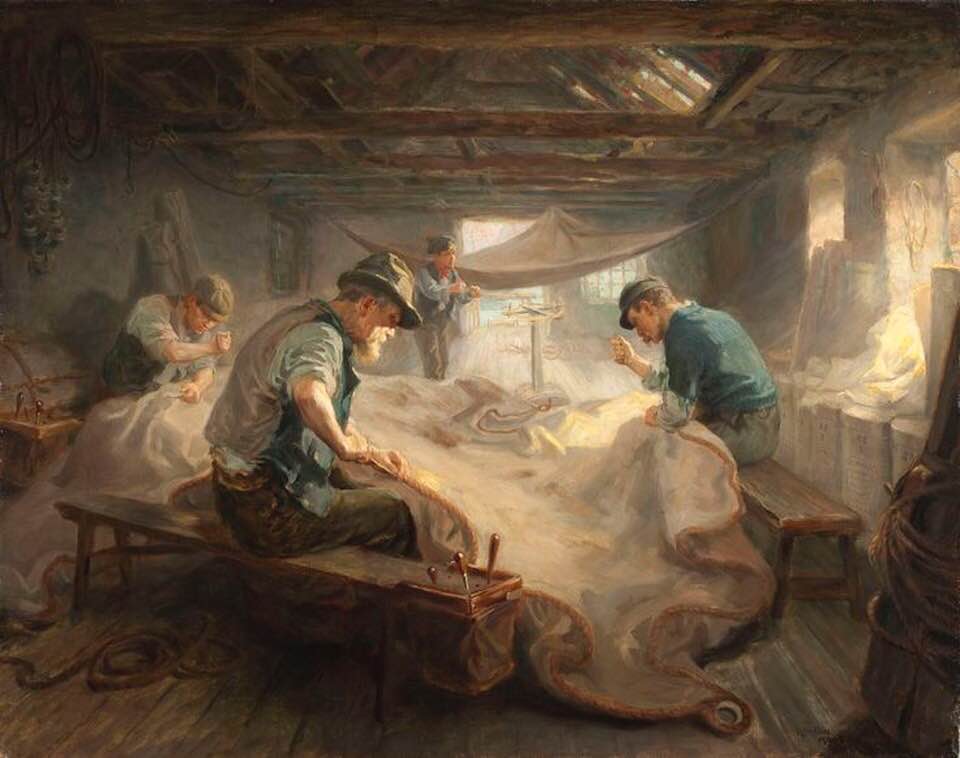Sailmaker
Sailmakers are most common near a shipwright or on a ship in order to make any needed repairs.
Career
Qualifications
Formal education is not required. Most of what anyone needs to know will be picked up while in the apprenticeship portion of their service. Of course, anyone that pursues an education can generally progress quicker.
Career Progression
Sail makers normally start out around the age of 10 years old as runners and messengers. Around the age of 13 they can become an apprentice and must perform very laborious duties such as picking up and delivering raw materials, taking the raw material to where they are to be made into fabric, carrying bolts of heavy fabric from one location to another, ensuring that the Master Sail Makers never run out of canvas, thread or needles and cleaning up the work area before and after each work day. Finally by age 17 they are allowed to make their first sail and are now known as Sail Maker. Most Sail Makers spend the rest of their lives living day to day and never really advance any further. The ones that do become Master's, generally do not do so before the age of 40.
Very rarely does anyone ever become a Sail Maker before they turn 17. Andrew McKim however, became a Sail Maker at the age of 15 and a Master Sail Maker before he turned 20.
Payment & Reimbursement
Sail makers that make their living on the docks or in the harbor generally get paid by commission. In this case, each one tries their hardest to make the best quality pieces so that they have many repeat and new customers.
The other sail makers spend their days and nights aboard ships just in case there is a need for their services. These individuals get paid per voyage, usually at the conclusion of each trip.
Perception
Purpose
Without the sail makers, ships and those that rely on them for their professions would not be able to function.
Demographics
Sail making is a highly specialized profession and is highly sought after near harbors and docks.
Operations
Tools
Canvas ditty bags with small tools and personal items. Some, like seam rubbers and serving mallets, have highly specialized uses for sail making or rigging, while others were more versatile. Most of the tools or containers carried in a sailor's bag are made from organic materials - hardwoods, bone, horn, leather and hemp. Sailor tools or boxes made from metals such as iron and high carbon steel, are highly vulnerable to the effects of oxidation in the marine environment, have limited application for needles, forged hooks and knives. Tin or brass are used for the thimbles of leather palms.
Fids & Bodkins:
Wooden or bone fids and bodkins are nearly always among the contents of ditty bags. Fids are blunt tipped cones of various lengths, usually lathe turned, and used to separate rope strands or "marl" when splicing. Usually these are of wood, though were sometimes made of whalebone or vintage hardwood fid, bovine bone bodkin, beeswax square Iron marlin spikes, used for the same purpose as fids. Bodkins are very small awls made of bone or pointed wood that are used for needle hitching and other fine sewing and splicing tasks. Riggers made use of them and probably sail makers as well. Sailmakers needles come in different sizes and some are also curved, that came with the needle case. Keeping needles in a rust and mildew proof container is essential at sea. Probably among the oldest is the grease horn. These are tips of ox horn, sometimes with a small leather thong to attach it to a sail maker's bench, containing iron needles impaled in tallow. These are more practical for use on land but are sometimes found in association with ditty bags. The other type consists of hollowed out wooden tubes with fitted end caps, usually lathe turned and sometimes covered in needle grafted or hitched macrame twine coated with tar. Hemp seaming twine requires wax, the same as for lighter linen thread, and for this there is beeswax.Seaming and Rigger's Palms:
A leather palm with a rawhide or metal thimble was a requirement for cordwainers and other leather two vintage seaming palms workers as well as for sail makers and riggers to protect their hands when pressing needles through thick materials. The same basic style of seaming palm was used interchangeably among the leather working and sail making professions, but riggers eventually developed a specialized palm that more fully protected the thumb. The contents of ditty bags almost always include palms, sometimes several of them.Bench Hooks:
Fixed sail makers' bench hook with a fixed eye. The sail maker needs to keep the canvas taught when sewing with needle and palm, and his "third hand" is a tool known as a bench hook or sail hook. This is an iron hook with a narrow, sometimes even scorpion-tailed tip, and is attached by a hemp cord to the workbench or another item well fixed in place and so the sailcloth could be pulled tight without piercing it.Rigging / Sail Maker's Knives & Sailor's Clasp Knives:
The knives used by riggers and sail makers do not have narrow points. The older ones have either squared tips or sheepsfoot blades, ideal for cutting heavy canvas without tearing.Ward Coles of the Easthaven Docks tells me; " A properly forged knife with an equally appropriate drawn temper should take not only the repeated blows of a mallet but also resist deformation, especially with a heavy 1/4" spine."
Serving Mallets and Serving Boards:
Serving mallet Natural rope fibers are vulnerable to rot, a particular problem for a sailing vessel's standing rigging that is constantly exposed to the elements. The solution is having a rigging diameter became cylindrical, then wrapped in the same direction - with the lay - with strips of tarred canvas. This was secured by "serving '' small diameter marline as tight as possible all the way down the cable in the opposite direction. The tools used to serve the large diameter rigging were known as serving mallets and were almost always made of hardwoods. Over time the groove in the side of the mallet would become worn down from constant abrading against the wrapped rigging, with well used examples appearing almost crescent shaped in profile. The marline would also wear grooves in the mallet on either side of the handle. For smaller diameter rope there were serving boards made from a single piece of hardwood (or whale lignum vitae serving mallet and mahogany seam rubber bone) with a curved, almost scooped head. A sail maker would do this with a hardwood (or whale bone) tool that came to be known as a seam rubber.
Type
Engineering
Demand
Sail Makers are in high demand along the coast and in the harbor.
Other Associated professions
Used By
Sail Repair
"Being able to repair your sails while at sea can mean the difference between life and death." Captain MakatsaMost ships have a number of sailors that are capable of repairing the ship's sails, but the best Captains hire those that have mastered the ability to repair sails under any circumstance.
Remove these ads. Join the Worldbuilders Guild














Comments